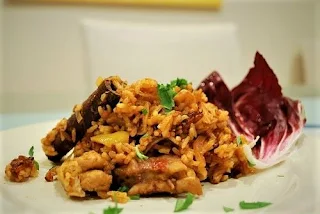Cuisine is a fascinating reflection of culture, history, and regional diversity. In this article, we embark on a culinary journey to compare two remarkable dishes from different corners of the world: Pilau from East Africa and Jambalaya from the United States. Despite their geographical and cultural differences, these dishes share similarities and bring unique flavors to the table.
Pilau Rice a taste of East Africa.
Originating from East Africa, Pilau is a beloved dish that holds deep cultural significance in countries such as Kenya, Tanzania, and Uganda. This aromatic and spiced rice dish is a celebration of flavors and textures. Let's dive into its history and preparation.
Pilau has a rich history intertwined with the Arab and Indian influences in East Africa. It is believed to have been introduced by traders and settlers who brought with them a variety of spices and cooking techniques. Over time, Pilau evolved and adapted to local ingredients and tastes, becoming a cherished dish in the region.
Pilau rice is a masterpiece of East African cuisine. Its vibrant colors, aromatic spices, and delectable flavors make it a culinary delight that transports the diner to distant lands with every bite. From the first scent to the last taste, Pilau rice invites you on a sensory journey that celebrates the richness of East African traditions and leaves a lasting impression on your palate.
Pilau rice is often served as a companion to a variety of dishes, ranging from succulent stews and curries to grilled meats and vegetables. Its versatility ensures that it can elevate any meal, complementing and enhancing the flavors of the main course.
Recipe for Pilau an East African Pilau Rice.
Pilau Ingredients.
2 cups basmati rice
1 pound meat (chicken, beef, or goat), cut into pieces
1 large onion, finely chopped
3 cloves of garlic, minced
2 carrots, diced
1 cup green peas
2 tablespoons vegetable oil
2 teaspoons cumin
1 teaspoon cardamom
1 teaspoon cloves
1 cinnamon stick
Salt to taste
Directions for East African Pilau Rice.
In a large pot, heat the vegetable oil and sauté the onions and garlic until golden brown. Add the meat to the pot and cook until browned. Add the spices (cumin, cardamom, cloves, and cinnamon) and stir well to coat the meat. Add the rice, carrots, peas, and salt. Mix everything together. Pour in enough water to cover the rice by about an inch.
Bring the mixture to a boil, then reduce the heat to low, cover, and simmer for about 20-25 minutes until the rice is cooked and fluffy. Once done, fluff the rice with a fork and serve hot with a side salad or yogurt.
 |
| Jambalaya |
Jambalaya is a Cajun Delight from the United States.
Originating from the southern United States, particularly Louisiana, Jambalaya is a flavorful and hearty one-pot rice dish. Its roots lie in the fusion of French, Spanish, African, and Caribbean cuisines, making it a true reflection of the region's diverse culinary heritage.
The flavors of Jambalaya are a true revelation. The spices, a testament to the Cajun and Creole influences, intertwine seamlessly, creating a harmonious melody on the tongue. The smoky paprika, aromatic thyme, and fragrant oregano come together to form a bold and robust flavor profile that is both comforting and unforgettable. The dish carries a slight heat, thanks to the judicious use of cayenne pepper or other spices, providing a gentle kick that enhances the overall experience.
Jambalaya, often enjoyed as a main course, is a dish that brings people together. Whether shared at a festive gathering or enjoyed as a comforting meal at home, it embodies the warmth and hospitality of the southern United States. It is a dish that unites people, encouraging laughter and conversation as plates are passed around and stories are shared.
Jambalaya is a sensory journey that celebrates the vibrant flavors and rich cultural heritage of the southern United States. From the visual delight of its colorful ingredients to the tantalizing aromas that fill the air, and from the harmonious blend of textures to the unforgettable taste experience, Jambalaya is a culinary masterpiece that leaves an indelible mark on your palate and heart.
Recipe for Jambalaya.
Ingredients for Jambalaya.
1 pound chicken, cut into pieces
1 pound smoked sausage, sliced
1 large onion, chopped
1 bell pepper, diced
2 stalks celery, diced
3 cloves of garlic, minced
1 can diced tomatoes
2 cups long-grain rice
4 cups chicken broth
2 teaspoons paprika
1 teaspoon dried thyme
1 teaspoon dried oregano
1/2 teaspoon cayenne pepper
Salt and black pepper to taste
Directions for Jambalaya.
In a large pot or Dutch oven, heat some oil over medium heat. Add the chicken and sausage, and cook until browned. Remove them from the pot and set aside. In the same pot, add the onions, bell peppers, celery, and garlic. Sauté until softened.
Stir in the diced tomatoes, rice, paprika, thyme, oregano, cayenne pepper, salt, and black pepper.
Return the chicken and sausage to the pot and pour in the chicken broth. Bring the mixture to a boil, then reduce the heat to low, cover, and simmer for about 20-25 minutes until the rice is cooked and has absorbed the flavors. Once done, let it rest for a few minutes, then fluff the rice with a fork and serve hot. It pairs well with cornbread or crusty bread.
 |
| Eating dinner in Kenya. |
Pilau from East Africa and Jambalaya from the United States are two remarkable dishes that showcase the culinary diversity and cultural heritage of their respective regions. Both dishes use rice as a base and incorporate a medley of spices, proteins, and vegetables to create unique flavors and textures. Whether you savor the fragrant and spicy Pilau or indulge in the bold and robust Jambalaya, these dishes offer a delightful experience for food enthusiasts around the world.





